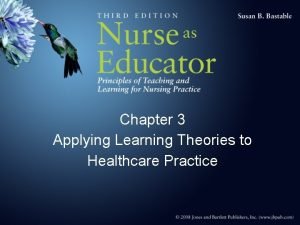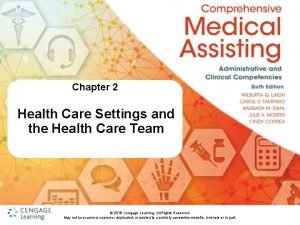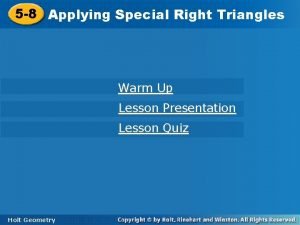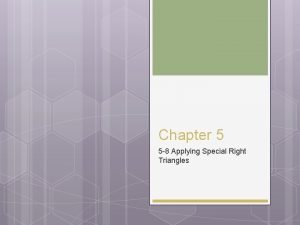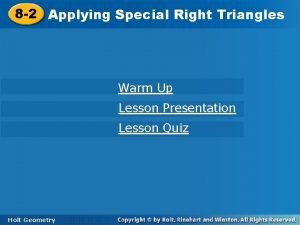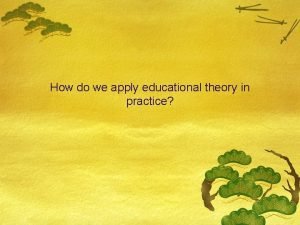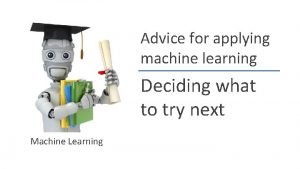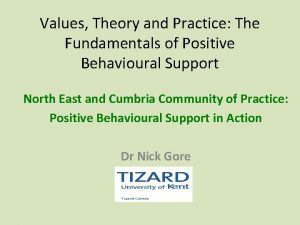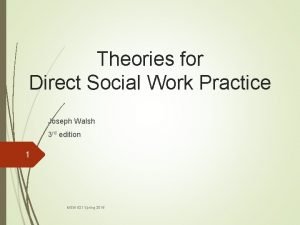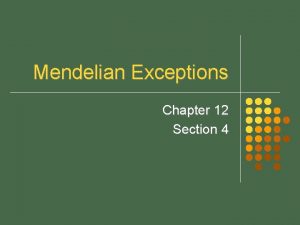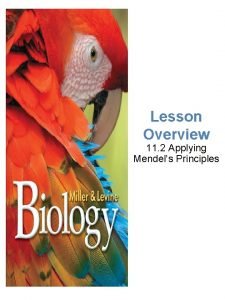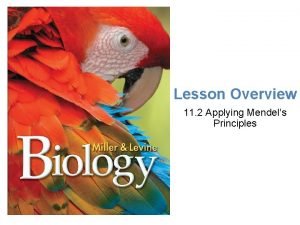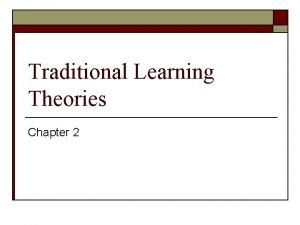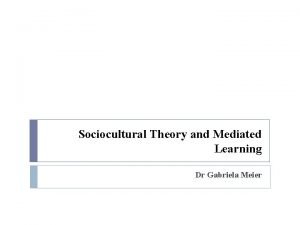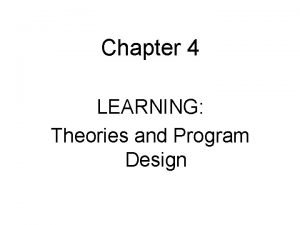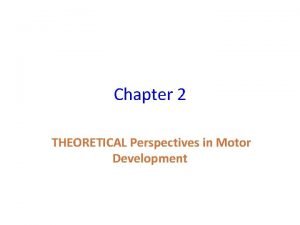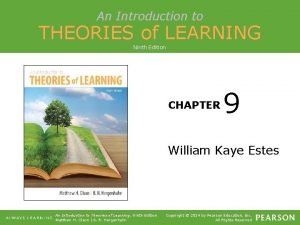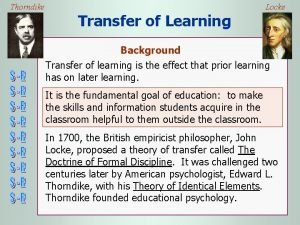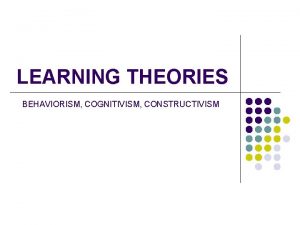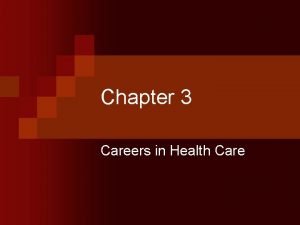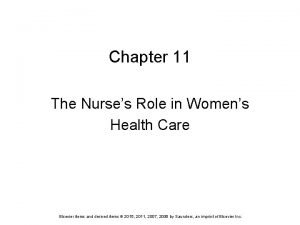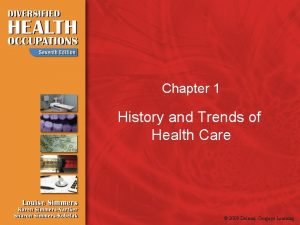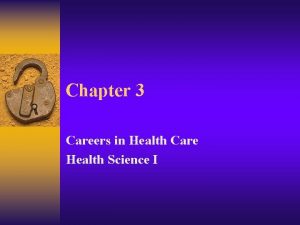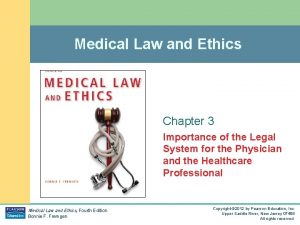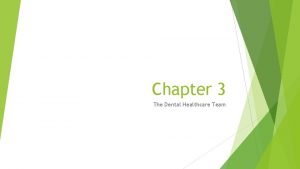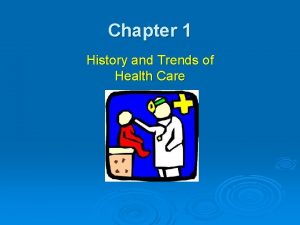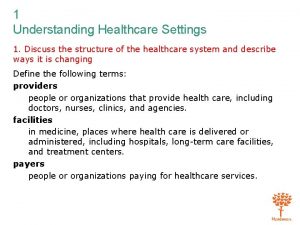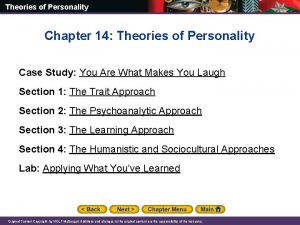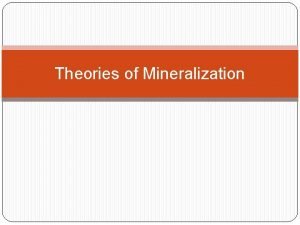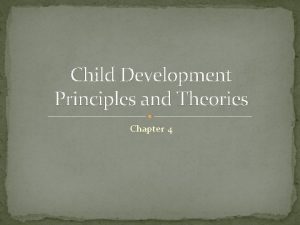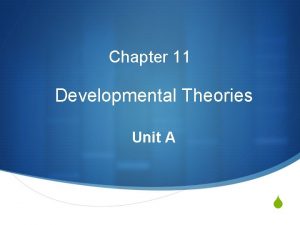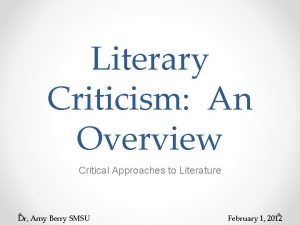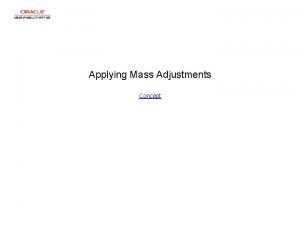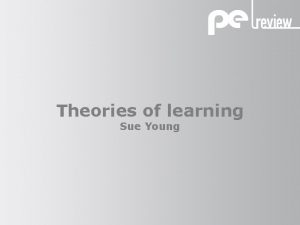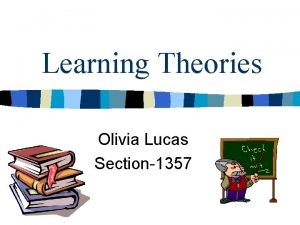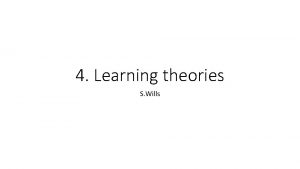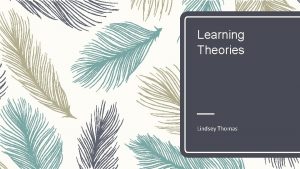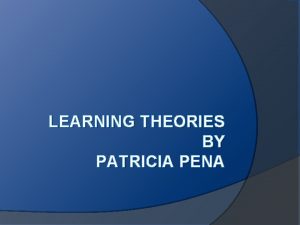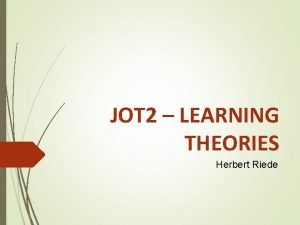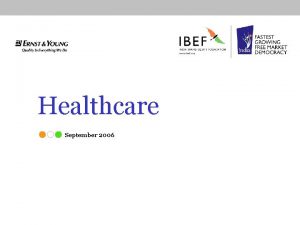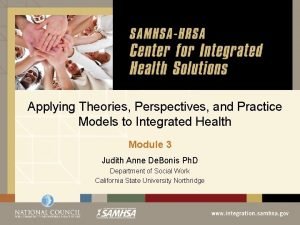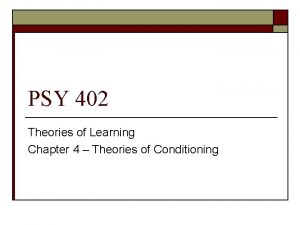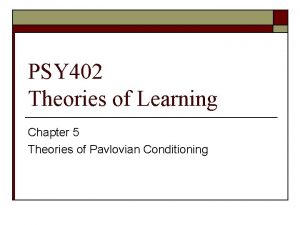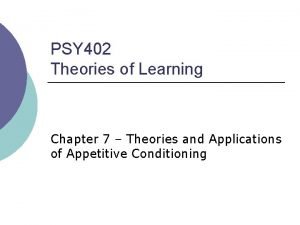Chapter 3 Applying Learning Theories to Healthcare Practice








































- Slides: 40

Chapter 3 Applying Learning Theories to Healthcare Practice

LEARNING • Learning: a relatively permanent change in mental processing, emotional functioning, and behavior as a result of experience • Learning Theory: a coherent framework of integrated constructs and principles that describe, explain, or predict how people learn

CONTRIBUTION OF LEARNING THEORIES • Provides information and techniques to guide teaching and learning • Can be employed individually or in combination • Can be applied in a variety of settings as well as for personal growth and interpersonal relations

Application Questions to Keep in Mind • How does learning occur? • What kinds of experiences facilitate or hinder the process? • What held ensure that learning becomes permanent?

BEHAVIORIST THEORY • Concepts: stimulus conditions, reinforcement, response, drive • To change behavior, change the stimulus conditions in the environment and the reinforcement after a response

Behaviorist Dynamics • Motivation: drives to be reduced, incentives • Educator: active role; manipulates environmental stimuli and reinforcements to direct change • Transfer: practice and provide similarity in stimulus conditions and responses with a new situation

Respondent Conditioning • Learning occurs as the organism responds to stimulus conditions and forms associations • A neutral stimulus is paired with an unconditioned stimulus–unconditioned response connection until the neutral stimulus becomes a conditioned stimulus that elicits the conditioned response

Operant Conditioning • Learning occurs as the organism responds to stimuli in the environment and is reinforced for making a particular response. • A reinforcer is applied after a response strengthens the probability that the response will be performed again under similar conditions.

Changing Behavior Using Operant Conditioning • To increase behavior – positive reinforcement – negative reinforcement (escape or avoidance conditioning) • To decrease behavior – nonreinforcement – punishment

Advantages of Behaviorism • Highly structured situations • Skills training in which steps and sequences can be clearly delineated

Disadvantages of Behaviorism • Instruction is mechanistic • Minimizes student involvement in learning • Inappropriate for complex mental processes, problem-solving, and critical thinking

COGNITIVE THEORY • Concepts: cognition, gestalt, perception, developmental stage, informationprocessing, memory, social constructivism, social cognition, attributions • To change behavior, work with the developmental stage and change cognitions, goals, expectations, equilibrium, and ways of processing information

Cognitive Dynamics • Motivation: goals, expectations, disequilibrium, cultural and group values • Educator: organize experiences and make them meaningful; encourage insight and reorganization within learner • Transfer: focus on internal processes and provide common patterns with a new situation

Gestalt Perspective • Perception and the patterning of stimuli (gestalt) are the keys to learning, with each learner perceiving, interpreting, and reorganizing experiences in her/his own way • Learning occurs through the reorganization of elements to form new insights and understanding

Information-Processing Perspective • The way individuals perceive, process, store, and retrieve information from experiences determines how learning occurs and what is learned. • Organizing information and making it meaningful aids the attention and storage process; learning occurs through guidance, feedback, and assessing and correcting errors. • Focus on describing the way information is tracked, the sequence of mental operations, and the results of operations.

Cognitive Development Perspective • Learning depends on the stage of cognitive functioning, with qualitative, sequential changes in perception, language, and thought occurring as children and adults interact with the environment. • Recognize the developmental stage and provide appropriate experiences to encourage discovery.

Social Constructivist Perspective • A person’s knowledge may not necessarily reflect reality, but through collaboration and negotiation, new understanding is acquired. • Learning is development • Assimilation, accommodation, & construction are part of learning

Social Constructivist Perspective ( cont) • Learning is heavily influenced by the culture and occurs as a social process in interaction with others. • A learner constructs new knowledge by building on internal representations of existing knowledge thru personal interpretation of experience.

Social Cognition Perspective • An individual’s perceptions, beliefs, and social judgments are affected strongly by social interaction, communication, groups, and the social situation. • Individuals formulate causal explanations to account for behavior that have significant consequences for their attitudes and actions (attribution theory).

SOCIAL LEARNING THEORY • Concepts: role modeling, vicarious reinforcement, self-system, selfregulation • To change behavior, utilize effective role models who are perceived to be rewarded, and work with the social situation and the learner’s internal selfregulating mechanisms

Social Learning Dynamics • Motivation: compelling role models perceived to be rewarded, self-system regulating behavior, self-efficacy • Educator: model behavior and demonstrate benefits; encourage active learner to regulate and reproduce behavior • Transfer: similarity of setting, feedback, self-efficacy, social influences

COGNITIVE THEORY-Advantages • Use of intellectual development gives teacher ↑ professional & personal satisfaction • ↑ satisfaction in relationship with learner • ↑ Increased use of a variety of instructional strategies → teacher creativity • ↑ learner satisfaction as move into improved cognitive ability & look forward to more challenging/ stimulating life • ↑ Critical thinking in learner

COGNITIVE THEORY-Disadvantages ↑ time & energy by teacher to become knowledgeable about different viewpoints Students stressed if looking for certainty or absolute answers

PSYCHODYNAMIC THEORY • Concepts: stage of personality development, conscious and unconscious motivations, ego-strength, emotional conflicts, defense mechanisms • To change behavior, work to make unconscious motivations conscious, build ego-strength, and resolve emotional conflicts

Psychodynamic Dynamics • Motivation: libido, life force, death wish, pleasure principle, reality principle, conscious and unconscious conflicts, developmental stage, defenses • Educator: reflective interpreter; listen and pose questions to stimulate insights • Transfer: remove barriers such as resistance, transference reactions, and emotional conflicts

HUMANISTIC THEORY • Learning occurs on the basis of a person’s motivation, derived from needs, the desire to grow in positive ways, self-concept, and subjective feelings. • Learning is facilitated by caring facilitators and a nurturing environment that encourage spontaneity, creativity, emotional expression, and positive choices.

Humanist Dynamics • Education motivates student to develop their potential & progress to self-actualization • Motivation: needs, desire to grow, selfconcept • Educator: act as facilitator who respects learner’s uniqueness and provides freedom to feel, express, and grow creatively • Transfer: positive or negative feelings and choices as well as freedom to learn, promote, or inhibit transfer

HUMANISTIC THEORY- Advantages • Focuses on honesty, Integrity, manners, respect for others, & accepting responsibility for self-development • Students engage in all aspects of learning experiences—teachable moments • Appropriate for learning critical thinking, problem solving, & different points of view.

HUMANISTIC THEORY- Disadvantages • Direction by faculty is necessary to ensure all domains of learning are adequately addressed.

Neuropsychology and Learning • Brain and nervous system information processing • Neurological conditions, mental health issues, and learning disabilities • Relationship between stress and learning • Integration of learning theories

Generalizations about Learning • Learning is a function of developmental changes • Brain processing is different for each learner • Learning is active, multifaceted and complex • Stress can interfere with or stimulate learning

ENVIRONMENTAL INFLUENCES (external) • stimulus conditions and configuration of elements • social and cultural influences • role models, experts, and guides • reinforcements • feedback

LEARNER INFLUENCES (internal) • • developmental stage habits perception thoughts and reasoning schema ways of processing information memory storage

LEARNER INFLUENCES (internal) • • conscious and unconscious motivation self-regulation subjective feelings self-concept expectations goals needs

How to promote change • Relate to what learner knows and is familiar with • Keep experiences simple, organized, and meaningful • Motivate learner (deprivation, goals, disequilibrium, needs, tension) • May need incentives and rewards, but not always

How to promote change • Experiences must be at the appropriate developmental level • Make learning pleasurable, not painful • Demonstrate by guidance and attractive role models

How to make learning relatively permanent • Relate experiences to learner • Reinforce behavior • Rehearse and practice in variety of settings • Have learner perform and give constructive feedback • Make sure interference does not occur before, during, or after learning

How to make learning relatively permanent (cont’d) • Promote transfer • Have learner mediate and act on experience in some way (visualize, memory devices, discuss, talk, discuss, write, motor movement)

State of the Research Evidence • Tests and modifies theories, methods, and assumptions • Challenges conventional wisdom and myths • Interdisciplinary focus is beneficial • Lack of resources is hindrance

Questions to Consider • In what ways do the learning theories differ? • In what ways are they similar? • How can the learning theories be used in combination to change behavior and enhance learning? • Why are some theories more effective with certain individuals than with others?
 Cognitive learning theory
Cognitive learning theory Applying learning theories to healthcare practice quizlet
Applying learning theories to healthcare practice quizlet Healthcare and the healthcare team chapter 2
Healthcare and the healthcare team chapter 2 Sports medicine meaning
Sports medicine meaning 8-3 lesson quiz geometry
8-3 lesson quiz geometry 5-8 practice b applying special right triangles
5-8 practice b applying special right triangles Special right triangles (radical answers)
Special right triangles (radical answers) Applying educational theory in practice
Applying educational theory in practice Advice for applying machine learning
Advice for applying machine learning Cuadro comparativo de e-learning b-learning y m-learning
Cuadro comparativo de e-learning b-learning y m-learning Theories and values of positive practice
Theories and values of positive practice Theories for direct social work practice
Theories for direct social work practice Chapter 12 lesson 2 applying mendels principles
Chapter 12 lesson 2 applying mendels principles Chapter 12 lesson 2 applying mendels principles
Chapter 12 lesson 2 applying mendels principles Chapter 12 lesson 2 applying mendel's principles
Chapter 12 lesson 2 applying mendel's principles Chapter 33 applying paints and enamels
Chapter 33 applying paints and enamels Chapter 12 lesson 2 applying mendels principles
Chapter 12 lesson 2 applying mendels principles Chapter 17 providing first aid
Chapter 17 providing first aid Traditional learning theories
Traditional learning theories Sociocultural theories of learning
Sociocultural theories of learning Learning theories and program design
Learning theories and program design Motor development theories
Motor development theories An introduction to theories of learning
An introduction to theories of learning Thorndike theory of learning
Thorndike theory of learning Differentiated learning theories
Differentiated learning theories Behaviorism vs constructivism vs cognitivism
Behaviorism vs constructivism vs cognitivism Chapter 3 careers in healthcare
Chapter 3 careers in healthcare Chapter 11 the nurse's role in women's healthcare
Chapter 11 the nurse's role in women's healthcare Chapter 1 history and trends of healthcare
Chapter 1 history and trends of healthcare Multicompetent worker definition
Multicompetent worker definition Chapter 3 healthcare laws and ethics
Chapter 3 healthcare laws and ethics Name the members of the dental healthcare team
Name the members of the dental healthcare team Test chapter 1 history and trends of health care
Test chapter 1 history and trends of health care Healthcare settings
Healthcare settings Chapter 14 theories of personality worksheet answers
Chapter 14 theories of personality worksheet answers Theories of mineralization of calculus
Theories of mineralization of calculus Child development principles and theories answer key
Child development principles and theories answer key Firm based trade theory
Firm based trade theory Chapter 11 developmental theories
Chapter 11 developmental theories Myeplg
Myeplg Approaches to literary criticism
Approaches to literary criticism

